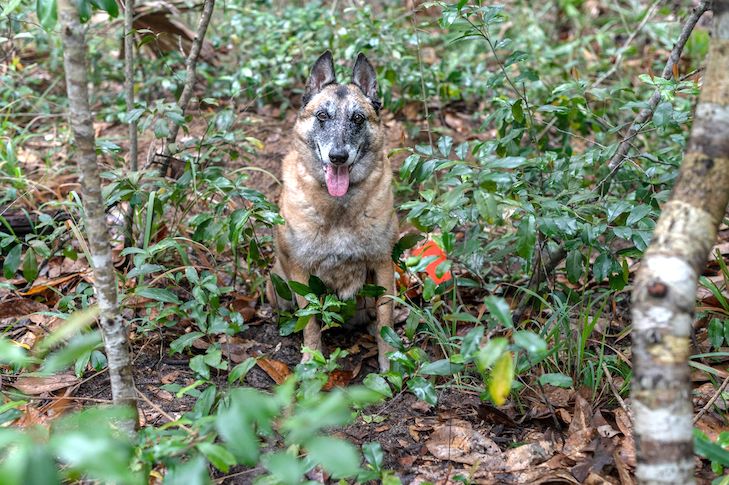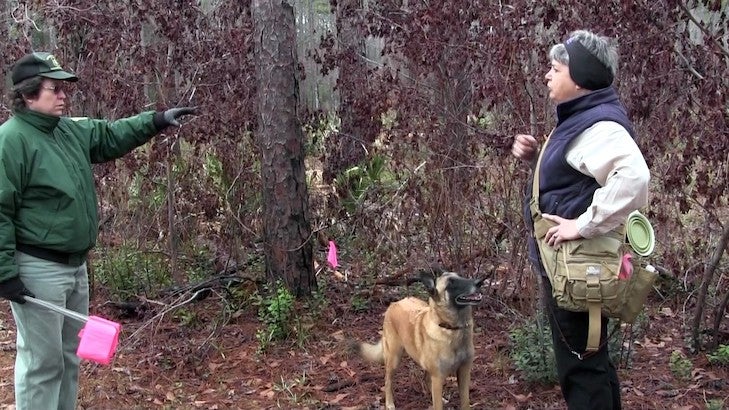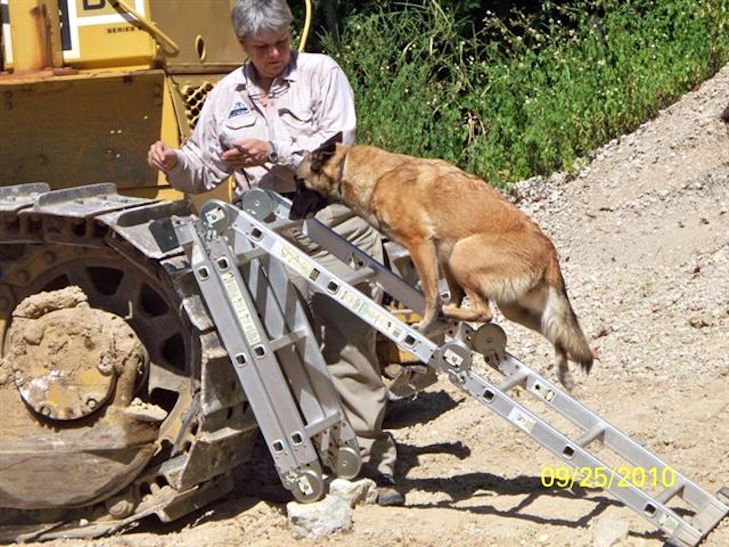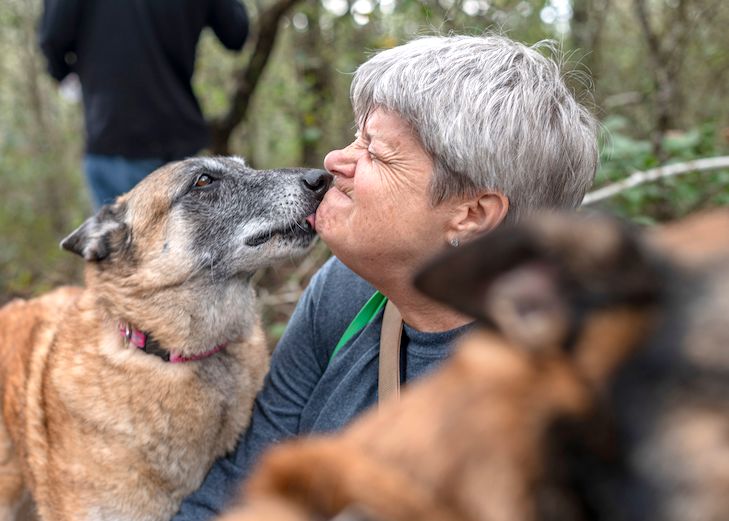
Each year, the AKC Humane Fund pays tribute to five dedicated, hardworking dogs for making significant contributions to an individual or entire community. One award is given in each of the following categories: Uniformed Service K-9, Service, Therapy, Search and Rescue, and Exemplary Companion Dog.
Like a good wine, Shiraz seems to just keep getting better with age.
The 12-year-old Belgian Malinois, owned by Susan Goodhope, of Havana, Florida, has a nose for her targets, some of which are decades and centuries-old and strewn across seven Southeast states from cemeteries to archeological sites.
The 50-pound human-remains detection dog (she’s a conformation champion, too) has taken part in more than 70 searches, made some incredible finds, and is the winner of the American Kennel Club Humane Fund Awards For Canine Excellence (ACE) Sponsored by Eukanuba Search and Rescue Dog category.
Becoming a Human-Remains Detection Dog
Shiraz comes from a Bord du Lac Kennels (Wilsonville, Alabama) litter of five, all with wine-oriented registered names like Meritage (Merri), Syrah (Rosie), and Sommelier (Sammy).
Goodhope, an obedience and cadaver dog trainer, saw search potential in the nimble Shiraz at age 3 months. “She was very keen to please, smart, and loved treats, which she receives after a find,” says Goodhope. Since then, it’s been an umbilical connection between the two.
While some of their calls have been from police and sheriff agencies, the bulk have been for searching out archaeological and lost gravesites.
And, oh, yes, each work outing begins with Goodhope’s command, “Sit. Ready. Find Hoffa!”
(There is no command for a dog to find human remains. Each handler picks his/her own. Goodhope was seeking to come up with the perfect, long-standing one, and a friend came up with Find Hoffa, and she’s used it since. Those of a certain age get the name recognition. Younger folks, not so much.)

Finding Human Remains From 670 AD
Of late, her focus been working with the National Park Service through the Southeast Archaeological Services in Tallahassee, Florida. The archaeological assignments often include weeks to months of planning.
Earlier this year, Team Shiraz was part of a search team of cadaver dogs and archaeologists seeking to find a lost cemetery on five acres of wooded terrain on the MacDill Air Force Base in Tampa, Florida, since the early 1900s. Historians believe the base is home to the Port Tampa Cemetery for African Americans.
Some graves, she adds, held the remains of stillborn babies (according to death certificates) which tend to decompose quickly. Deed records, newspaper clippings, and relatives’ remembrances of a cemetery all become part of the archival data utilized prior to and during the search.
But don’t think that’s too old for Shiraz.
During a 2013 archeological search in the Florida Panhandle, Shiraz’s target was a Native American burial mound referenced in the publication, “The West and Central Florida Expeditions of Clarence Bloomfield Moore.”
For eight years National Parks Service archeologist Jeff Shanks was unable to uncover it. He admitted to skepticism asking for a dog’s help, but finally accepted it. After searching for an hour in wooded, overgrown terrain, Shiraz indicated a find of human remains. Well, guess what? A human toe was recovered a meter underground that was radiocarbon dated to 670 AD!
What Does Shiraz Smell?
So what is Shiraz’s keen scent picking up? “It’s usually a mixture of volatile gases that decaying bodies give off,” says Goodhope, whose dogs sniff for more than 400 decomposition-related compounds emanating from human remains. The Southeast heat and humidity adds to the challenge of terrain, insects, snakes, and time, too. And occasionally an alligator.
“The target odor we believe is faint so the dogs must detect very low levels as well as breathe to cool off. In some situations, the target may have been leveled or disturbed by looters. Depending on the age of the mound the archeologist will have an area that is more probable which we will cover first, then move on to other sites,” Goodhope notes.

Memories of a Lifetime
Finding a Cemetery of Enslaved People
Several years ago, Goodhope was asked to go to Melrose Plantation in Naches, Mississippi, to assist a team of archeologists in locating a cemetery of enslaved people. She was given an area they wished to search and after a short period, they were joined by a member of the plantation staff who watched Shiraz work.
As they made their way through a heavily wooded area, Shiraz gave her trained final response, a sit, at which Goodhope placed a small flag in the ground indicating the dog identified an odor of decomposition.
“At that point,” she recalls, “I heard someone crying. I turned to see the plantation worker slowly dabbing his eyes and saying, ‘Those are my people. Those are my people.’ I was surprised to see this elegant, tall, well-built African American man show so much emotion. I babbled something about how there would have to be more work to confirm the graves. It was one of those memories of a lifetime.”
Identifying an Infant from 1955
Yet another poignant case occurred in North Carolina several years ago. A team of handlers was assisting in identifying a cemetery in front of a church. Plans were to expand a roadway adjacent to the church, and at end of the second day of searching a couple drove up and inquired what was going on.
“I explained how cadaver dogs assist in locating old graves. She was amazed and asked if we could help find her baby. She recounted that she had an infant that died in 1955, then recalled visiting the gravesite once. When she returned later the temporary marker was gone. Her companion pointed to an area where they believed the grave was situated.
“I told them I would try, took their contact information and they left. I worked Shiraz in the area the gentleman pointed out, and she eventually gave her trained final sit response. I noted the area and asked another dog and handler who had not been present while Shiraz maneuvered the scene to check it out. That dog, too, indicated the same site as Shiraz. We informed officials and provided the pair’s contact information. I later heard that the woman’s other children planned to put a marker on that area. “
School for Boys
And then there was Arthur G. Dozier School for Boys, a state juvenile correction facility in Marianna, Florida, case prompting a highly publicized search for unmarked graves. Established in 1900 and later renamed the Florida Industrial School for Boys, it carried an abusive reputation in its early years. A nearby cemetery was active from about 1914-1952, although death certificates were not required prior to 1917. It is not known how many people are interred there, although state investigators believe at least 81.
“We were asked to survey specific locations in 2014,” Goodhope says. “The dogs’ trained final responses (their cue to handlers they had found a target odor) were then confirmed by another agency’s methodology such as ground-penetrating radar, exhumation or another modality.”

Shiraz the Comforter
But all of that aside, she has seen a new charismatic and engaging side of Shiraz this year after the passing of her husband, Robert, in June.
“His death coincided with COVID so there were days when I was not able to see him in the hospital. Shiraz was very affectionate and loving through those trying times and knew something was amiss. If I was upset, she would come to me and put her head on my leg until I petted her and took to sleeping at the foot of my bed, a new behavior for her.
“She got me moving every morning as did the other animals (Goodhope lives on 11 acres). Their needs kept me grounded in a world I did not recognize.”
Shiraz has the run of the 11 acres along with her three companions, Fletch and Merci, 6- and 8-year-old Malinois, respectively, and 14-year-old Erin, an Irish Terrier. And then there’s Pâté, a 20 something Hanoverian gelding, who Shiraz prefers to avoid.
On a sad note, Shiraz was recently diagnosed with transitional cell carcinoma and a projected life span of six to 12 months.
The AKC National Championship is right around the corner, and you don’t want to miss the action! Tune in to ABC on December 31 at 2 p.m. ET to see who’s crowned Best in Show.
Did you miss last year’s show? You can watch the 2022 AKC National Championship Presented by Royal Canin on demand on AKC.tv!

